
We’re jumping a little ahead in Foghorn’s career to anticipate Valentine’s Day in this week’s installment of Foghorn February!
 Amidst the raucous slapstick of Foghorn Leghorn’s cartoons, this entry adds the elements of romance and marriage, whereas Chuck Jones’ Pepe le Pew cartoons are permeated with incongruous lust, in an amorous guise. Lovelorn Leghorn features the old spinster hen Miss Prissy, who debuted in an earlier McKimson Porky Pig cartoon, An Egg Scramble (1950). Her design is loosely based on Emily the Chicken, a character who appeared in three cartoons directed by Friz Freleng in the late ‘30s (Let It Be Me, Boulevardier from the Bronx, A Star is Hatched) Like Foghorn, Prissy’s voice was also influenced by radio; Pert Kelton’s dizzy rich woman Martha Harrison, on The Milton Berle Show, often haughtily responded with “Ye-e-e-e-e-es…” Bea Benaderet supplies Prissy’s voice in this cartoon, and would re-appear in later cartoons with Foghorn (Of Rice and Hen and Little Boy Boo, for instance.)
Amidst the raucous slapstick of Foghorn Leghorn’s cartoons, this entry adds the elements of romance and marriage, whereas Chuck Jones’ Pepe le Pew cartoons are permeated with incongruous lust, in an amorous guise. Lovelorn Leghorn features the old spinster hen Miss Prissy, who debuted in an earlier McKimson Porky Pig cartoon, An Egg Scramble (1950). Her design is loosely based on Emily the Chicken, a character who appeared in three cartoons directed by Friz Freleng in the late ‘30s (Let It Be Me, Boulevardier from the Bronx, A Star is Hatched) Like Foghorn, Prissy’s voice was also influenced by radio; Pert Kelton’s dizzy rich woman Martha Harrison, on The Milton Berle Show, often haughtily responded with “Ye-e-e-e-e-es…” Bea Benaderet supplies Prissy’s voice in this cartoon, and would re-appear in later cartoons with Foghorn (Of Rice and Hen and Little Boy Boo, for instance.)
Through studio politics, Bob McKimson’s former story-man Warren Foster was shifted to Freleng’s unit in the spring of 1949; Ted Pierce moved to McKimson’s unit. Pierce was a chronic womanizer, which was an appropriate fit for the material handled in Lovelorn Leghorn. The comedic implications of marriage are Pierce’s forte; Prissy uses a rolling pin to secure a husband — in this case, Foghorn. Harridan housewives wielding these blunt instruments were a staple of vaudeville and silent comedy, but perhaps could also suggest Maggie, the wife in George McManus’ popular comic strip Bringing Up Father. Foghorn makes a distinct comment to the audience about matrimony (“That comes later…”), after stating to Prissy that a rolling pin is the wrong approach.
In its first few entries, the Foghorn series used the same premise, with different variations on the formula that worked without much strain until around 1955’s releases. Lovelorn Leghorn is tightly structured around the Foghorn/Barnyard Dawg animosity and the love-starved Miss Prissy’s desires. In a brilliantly staged sequence (animated by Emery Hawkins) Miss Prissy entices the dog —which she assumes is a rooster in disguise— with a casaba melon to playfully chase her. Their chase ultimately turns into a football game as Foghorn enters, in uniform and leatherhead helmet, to use the melon in his own methods. The dog’s presence became more necessary as the cartoons evolved, instead of intermittently appearing on-screen when he was needed. Here, after hearing about Prissy’s needs, they work together on their own scheme, with “a couple of two-by-fours and a stepladder.”Around 1945, shortly after joining McKimson’s unit, Rod Scribner was hospitalized with tuberculosis and returned to the studio by March 1948. Scribner’s drawing/animation in Lovelorn Leghorn is wholly Scribner in some ways. For instance, the dog’s repulsed expression in scene 32, over the notion of being Prissy’s husband, is superb. However, McKimson wasn’t keen on the strengths he previously utilized in Clampett’s, or even in his first few cartoons as a director. McKimson later felt Scribner became a better animator when his work was calmer, but in reality it seems that he refused to accommodate animators, such as Scribner, with eccentric traits. Other scenes animated by Scribner are slightly restrained compared to his work in the ‘40s.
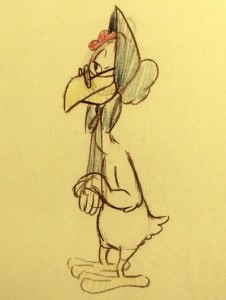 The draft indicates there is some uncredited animation by John Carey. His only scenes occur during the introductory sequences with Prissy and the gossiping hens. His absence in the opening credits might be due to Carey’s departure from the studio; he left by early 1950 to work on funny animal stories—mostly those featuring the Warners characters—for Western Publishing.
The draft indicates there is some uncredited animation by John Carey. His only scenes occur during the introductory sequences with Prissy and the gossiping hens. His absence in the opening credits might be due to Carey’s departure from the studio; he left by early 1950 to work on funny animal stories—mostly those featuring the Warners characters—for Western Publishing.
Two shots in the draft were ultimately excised; scene 5 was intended to be a close-up shot of another chicken, Clara, deriding Prissy, as she readies herself on her “husband hunting.” Evidently, in scene 12, Prissy would’ve been introduced later in the sequence, since the draft indicates Foghorn sharpens an axe and speaks to the audience. In the finished cartoon, the scene fades in to Prissy, rolling pin in hand. It’s also fascinating that Charles McKimson is credited for much of the effects animation in the sequence involving Prissy’s Rube Goldberg-esque trap.
Eugene Poddany is credited with the musical score, and Milt Franklyn for the orchestrations. Carl Stalling was recovering from a brain injury for several weeks; hence, both musicians are credited. Poddany was Stalling’s musical copyist, responsible for writing out the complete score, including the orchestral components, while Franklyn served as musical arranger. Franklyn became a musical director by 1953, while Stalling still composed his own scores. Poddany moved to John Sutherland Producers, and proceeded to continue scoring music for Walter Lantz and MGM’s Sib-Tower 12 Productions in the ‘60s.
Any of this information filterin’ through that little blue bonnet of yours? I hope this breakdown video does, too…
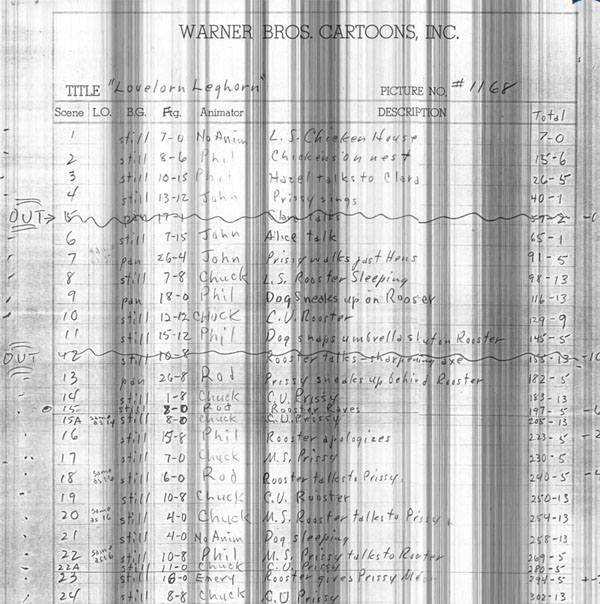
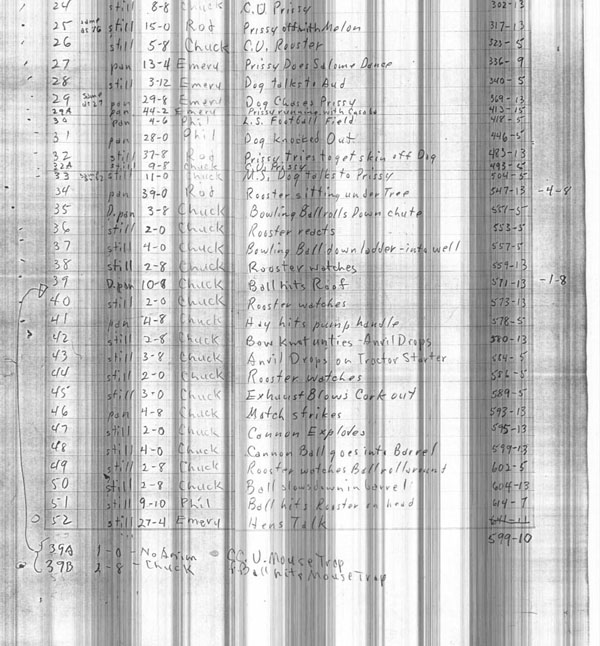
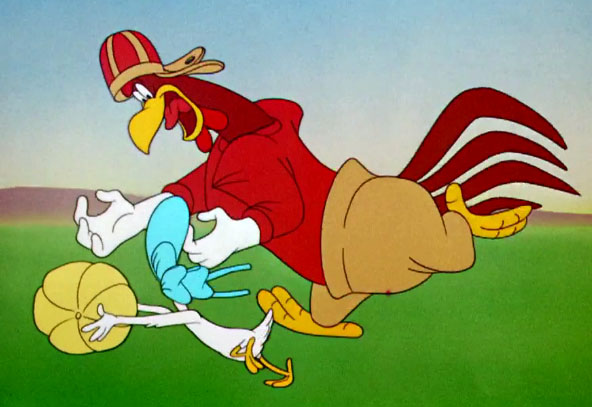
An Emery Hawkins sequence
(Thanks to Michael Barrier, Keith Scott, and Frank Young for their help.)


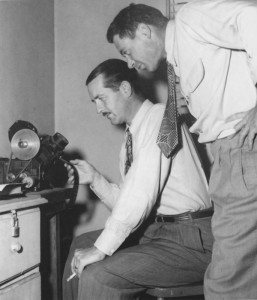
 DEVON BAXTER is a film restoration artist, video editor, and animation researcher/writer currently residing in Pennsylvania. He also hosts a
DEVON BAXTER is a film restoration artist, video editor, and animation researcher/writer currently residing in Pennsylvania. He also hosts a 





















































































I had know idea Eugene Poddany was around Warners at this time. I wonder if he ever met Jones around this time and kept in touch?
Yup. Eugene Poddany did a lot of the scores for Chuck Jones for the Tom & Jerry cartoons including Sno-body Loves Me and Tom-ic Energy as well as the score The Dot and The Line. Eugene Poddany also did the musical score for Walter Lantz.
Cartoon studios often worked toward creating an “everyman” character. Foghorn would best be described as “everyman’s dad”.
In An Egg Scrambled Mel Blanc provided Miss Prissy’s voice and June Foray was the voice of Miss Prissy’s chick who hatched out of the egg. Miss Prissy was also known as “Widder (Widow) Hen”.
The two funniest parts in Lovelorn Leghorn in when Miss Prissy (while trying to get Foghorn’s attention) did a crazy Flamenco dance to “Lady of Spain” and when Barnyard Dog dressed in a Rooster costume challenges Foghorn to a fight and lost on purpose to win Miss Prissy’s hand (or is it wing?) in marriage.
Bea Benadaret was chick Prissy (not that June Foray wasn;t at WB or other theatrticals in the 1940s once in a while). You’re describing, in your next sentence “Of Rice and Hen”,
The Foghorn cartoon you mentioned is actually OF RICE AND HEN (’53), another bona-fide classic.
I honestly don’t recall the look of the hen in the first HENERY HAWK cartoon, as Mama Hen begs Henery o eat his worm and, instead, he asks for a chicken, but I think the voice in that earlier Jones effort was Sarah Berner and she sounded nothing like Miss Prissy. I, too, like the dancing sequence that Miss Prissy does to lure the dog, believing it to be a rooster (“this cluck’s off her onion!”) with Miss Prissy exclaiming “he’s chasing me!” All in all, one of the great FOGGY cartoons.
Oops, my mistake, so Miss Prissy’s design is based on the skinny younger hen that appeared in “A STAR IS HATCHED”, one of my favorite cartoons that kind of parodied all those movies about starlets who tried and failed. Not meaning to veer away from the cartoon that is the entertaining subject of this particular post, but I wonder just which movie from Warner Brothers is the inspiration for this parody–was there ever a film in which the starlet traveled a great deal on foot to get into picures? I’m remembering the montage of the chick’s legs walking, walking, walking, and the various road signs coming at you from all directions; that was quite a sophisticated visual for this cartoon, but that kind of thing is what I liked about Warner Brothers cartoons…always adding elements of popular adult dramas and comedies of the period. That cartoon also featured what I would assume is a William Powell caricature, singing his odes to the Army the Navy and Marines, quickly slipping out of the scene, not missing a beat, to change for the next number, and the camera zooms in on his mouth as he finishes the last note, dissolving into the director yelling “cut!”
As expected, Rod Scribner and Emery Hawkins were responsible for my favorite bits of animation in this short.
This is one of Foghorn’s best, no doubt.
Kevin, you’re thinking of Dick Powell, not William Powell, caricatured in A STAR IS HATCHED (singing “Don’t Give Up the Ship,” from the movie THE SINGING MARINE). Yes, Sara Berner was Henery’s mother in THE SQUAWKIN’ HAWK from 1942. However June Foray wasn’t heard in a cartoon of the 1940s as Miss Prissy…in fact only once did she do Miss Prissy in the 1959 release A BROKEN LEGHORN. The role was also done by a couple of others when Bea stopped doing theatrical cartoons.